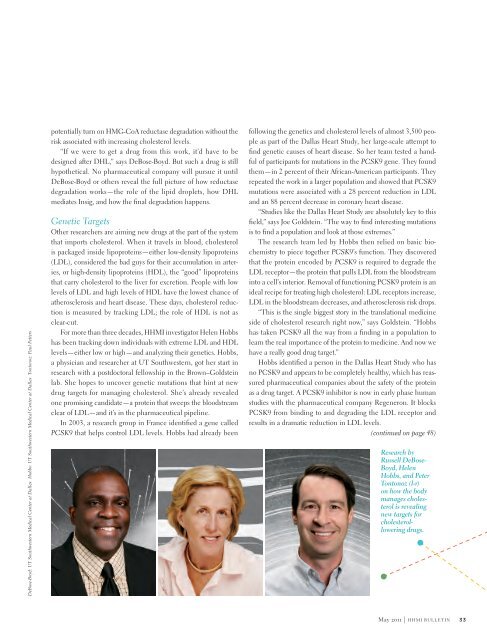Download PDF - Howard Hughes Medical Institute
Download PDF - Howard Hughes Medical Institute
Download PDF - Howard Hughes Medical Institute
You also want an ePaper? Increase the reach of your titles
YUMPU automatically turns print PDFs into web optimized ePapers that Google loves.
DeBose-Boyd: UT Southwestern <strong>Medical</strong> Center at Dallas Hobbs: UT Southwestern <strong>Medical</strong> Center at Dallas Tontonoz: Paul Fetters<br />
potentially turn on HMG-CoA reductase degradation without the<br />
risk associated with increasing cholesterol levels.<br />
“If we were to get a drug from this work, it’d have to be<br />
designed after DHL,” says DeBose-Boyd. But such a drug is still<br />
hypothetical. No pharmaceutical company will pursue it until<br />
DeBose-Boyd or others reveal the full picture of how reductase<br />
degradation works—the role of the lipid droplets, how DHL<br />
mediates Insig, and how the final degradation happens.<br />
Genetic Targets<br />
Other researchers are aiming new drugs at the part of the system<br />
that imports cholesterol. When it travels in blood, cholesterol<br />
is packaged inside lipoproteins—either low-density lipoproteins<br />
(LDL), considered the bad guys for their accumulation in arteries,<br />
or high-density lipoproteins (HDL), the “good” lipoproteins<br />
that carry cholesterol to the liver for excretion. People with low<br />
levels of LDL and high levels of HDL have the lowest chance of<br />
atherosclerosis and heart disease. These days, cholesterol reduction<br />
is measured by tracking LDL; the role of HDL is not as<br />
clear-cut.<br />
For more than three decades, HHMI investigator Helen Hobbs<br />
has been tracking down individuals with extreme LDL and HDL<br />
levels—either low or high—and analyzing their genetics. Hobbs,<br />
a physician and researcher at UT Southwestern, got her start in<br />
research with a postdoctoral fellowship in the Brown–Goldstein<br />
lab. She hopes to uncover genetic mutations that hint at new<br />
drug targets for managing cholesterol. She’s already revealed<br />
one promising candidate—a protein that sweeps the bloodstream<br />
clear of LDL—and it’s in the pharmaceutical pipeline.<br />
In 2003, a research group in France identified a gene called<br />
PCSK9 that helps control LDL levels. Hobbs had already been<br />
following the genetics and cholesterol levels of almost 3,500 people<br />
as part of the Dallas Heart Study, her large-scale attempt to<br />
find genetic causes of heart disease. So her team tested a handful<br />
of participants for mutations in the PCSK9 gene. They found<br />
them—in 2 percent of their African-American participants. They<br />
repeated the work in a larger population and showed that PCSK9<br />
mutations were associated with a 28 percent reduction in LDL<br />
and an 88 percent decrease in coronary heart disease.<br />
“Studies like the Dallas Heart Study are absolutely key to this<br />
field,” says Joe Goldstein. “The way to find interesting mutations<br />
is to find a population and look at those extremes.”<br />
The research team led by Hobbs then relied on basic biochemistry<br />
to piece together PCSK9’s function. They discovered<br />
that the protein encoded by PCSK9 is required to degrade the<br />
LDL receptor—the protein that pulls LDL from the bloodstream<br />
into a cell’s interior. Removal of functioning PCSK9 protein is an<br />
ideal recipe for treating high cholesterol: LDL receptors increase,<br />
LDL in the bloodstream decreases, and atherosclerosis risk drops.<br />
“This is the single biggest story in the translational medicine<br />
side of cholesterol research right now,” says Goldstein. “Hobbs<br />
has taken PCSK9 all the way from a finding in a population to<br />
learn the real importance of the protein to medicine. And now we<br />
have a really good drug target.”<br />
Hobbs identified a person in the Dallas Heart Study who has<br />
no PCSK9 and appears to be completely healthy, which has reassured<br />
pharmaceutical companies about the safety of the protein<br />
as a drug target. A PCSK9 inhibitor is now in early phase human<br />
studies with the pharmaceutical company Regeneron. It blocks<br />
PCSK9 from binding to and degrading the LDL receptor and<br />
results in a dramatic reduction in LDL levels.<br />
(continued on page 48)<br />
Research by<br />
Russell DeBose-<br />
Boyd, Helen<br />
Hobbs, and Peter<br />
Tontonoz (l-r)<br />
on how the body<br />
manages cholesterol<br />
is revealing<br />
new targets for<br />
cholesterollowering<br />
drugs.<br />
May 2o11 | h h m i b u l l e t i n<br />
33
















